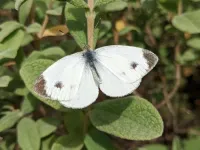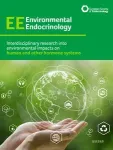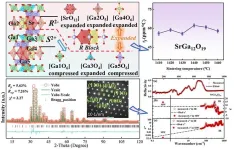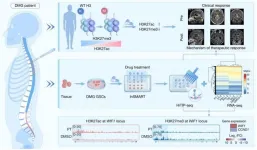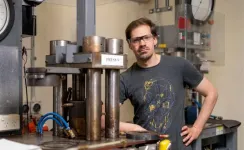(Press-News.org) Until a few years ago, the butterfly known as the southern small white could barely be found north of the Alps. That was before a Europe-wide invasion that brought a huge increase in the insect’s distribution – at the same time as a rapid decrease in genetic diversity within the species.
It took a while for zoologist Daniel Berner to notice that a butterfly species that wasn’t local to his area had become established in his garden. Then, suddenly, he saw it everywhere: Pieris mannii – also known as the southern small white – with its wingspan of around four centimeters and white wings adorned with large black spots.
Indeed, until a few years ago, only a few small, localized populations of this principally Mediterranean species existed in Switzerland, in Valais and Ticino. But at some point in around 2005, the butterfly began its journey north and east – and it has now been identified at the North Sea and in the Czech Republic.
Comparison with museum specimens
With its expansion, however, came a significant loss of genetic diversity. “We found that, as it invaded, the southern small white standardized local populations of its own species,” says Dr. Daniel Berner of the University of Basel. Together with researchers from the University of Greifswald and the Senckenberg German Entomological Institute, Berner has published a study in Current Biology investigating how the butterfly’s expansion has impacted diversity within its own species.
The researchers compared the genetic make-up of freshly caught butterflies with that of significantly older museum specimens – in other words, specimens that had been caught and preserved before the invasion began. In doing so, they demonstrated that the genetic composition of the researched local populations has changed considerably. Indeed, a large part of the original genetic make-up has now been replaced with that of the expanding population.
“If we hadn’t made the comparison with the museum specimens, we wouldn’t have spotted this genetic change,” says Berner. For their analyses, the researchers were able to sequence butterflies from the collection of the Natural History Museum of Bern and therefore to characterize the insects genetically. They were very lucky that, over the decades, the lepidopterist (butterfly researcher) Heiner Ziegler had amassed an extensive collection of specimens of none other than the southern small white – and that they could use this collection in their research.
Favorite plants in gardens
Urbanization is helping the butterfly to spread rapidly. In fact, the southern small white doesn’t like to fly long distances. Instead, it spends its lifespan of approximately three weeks fluttering around within a modest radius of its birthplace, in which the caterpillars’ food plants also thrive – namely arugula and, above all, candytuft. The latter is particularly widespread in gardens within settled areas. Accordingly, the increasing expansion of the built environment has given the southern small white the opportunity to spread far and wide.
Moreover, there are five or six generations of southern small white per year, rather than just one. “This species can therefore quickly build up large populations in a newly settled area, favoring the settlement of new land over large distances,” Berner explains. It is very likely, he says, that the butterfly will expand further – provided that its food plants are available. “In any case, butterfly researchers in England are just waiting to spot the first one.”
Expansion and genetic mixing – loss or gain?
From a conservation perspective, the expansion of the southern small white is a double-edged sword. As the species uses largely human-designed habitats in the newly settled area, it is not expected to compete with indigenous butterflies. Moreover, expansion means that this butterfly species is now much more numerous overall, which tends to reduce its risk of dying out. However, these positives are offset by the disappearance of genetic diversity that had built up over the course of millennia: “Although it’s the fate of living things that some local groups can die out, what’s special about the situation facing the southern small white is that the loss of original population diversity accompanies expansion of the built environment – and is therefore caused by humans.”
As yet, the researchers don’t know why the southern small white in particular has embarked on major expansion or where exactly this process began. “Presumably, nothing fundamentally new has happened on the side of the butterfly. So far, we haven’t found signs of major genetic change in the expansive population, and climate change doesn’t appear to play a key role in the situation,” says Berner. The researchers want to continue looking into these questions, but they already have their suspicions as to the starting point: the invasion may have begun in eastern France.
END
How a butterfly invasion minimizes genetic diversity
2024-09-24
ELSE PRESS RELEASES FROM THIS DATE:
Another Franklin expedition crew member has been identified
2024-09-24
The skeletal remains of a senior officer of Sir John Franklin's 1845 Northwest Passage expedition have been identified by researchers from the University of Waterloo and Lakehead University using DNA and genealogical analyses.
In April of 1848 James Fitzjames of HMS Erebus helped lead 105 survivors from their ice-trapped ships in an attempt to escape the Arctic. None would survive. Since the mid-19th century, remains of dozens of them have been found around King William Island, Nunavut.
The identification was made possible by a DNA sample from a living descendant, which matched the ...
SrGa12O19: The first low-εr Ga-based microwave dielectric ceramic with anomalous positive τf
2024-09-24
As one of the key materials of modern microwave communication technology, microwave dielectric ceramics are widely used in many core components of microwave circuits. In recent years, with the rapid development of microwave communication technology marked by mobile communication, in order to meet the requirements of the development of mobile communication technology, including 5G/6G, new requirements have been put forward for the performance parameters of microwave dielectric ceramics: low dielectric constant to reduce signal delay, low dielectric loss or high quality factor, and near-zero ...
HiTIP-seq profiles epigenomic reprogramming of patient-derived diffuse midline glioma stem cells to epigenetic therapy
2024-09-24
Diffuse midline glioma (DMG) is a highly aggressive and fatal pediatric high-grade glioma that primarily affects critical regions of the central nervous system, such as the pons, thalamus, and spinal cord. Due to the high surgical risks and poor prognosis associated with DMG, treatment options for patients are extremely limited. Conventional treatments, including surgery, radiotherapy, and chemotherapy, have shown limited efficacy, particularly with radiochemotherapy, which only temporarily controls tumor progression ...
SNU researchers develop ‘Selective Metal Films Deposition Technique’ enabling fabrication of soft electronics with various form factors
2024-09-24
Seoul National University’s College of Engineering announced that a research team led by Prof. Yongtaek Hong from the Department of Electrical and Computer Engineering, in collaboration with Prof. Byeongmoon Lee from the Department of Electrical Engineering and Computer Science at the Daegu Gyeongbuk Institute of Science and Technology (DGIST), has developed a ‘printing-based selective metal film deposition technique’ that enables the facile and fast fabrication of high-performance soft electronic devices and circuits in various ...
Extinct volcanoes a ‘rich’ source of rare earth elements
2024-09-24
A mysterious type of iron-rich magma entombed within extinct volcanoes is likely abundant with rare earth elements and could offer a new way to source these in-demand metals, according to new research from The Australian National University (ANU) and the University of the Chinese Academy of Sciences.
Rare earth elements are found in smartphones, flat screen TVs, magnets, and even trains and missiles. They are also vital to the development of electric vehicles and renewable energy technologies such as wind turbines.
Dr Michael Anenburg from ANU said the iron-rich magma that solidified to form some extinct volcanoes is up to ...
PSU English professor to lift curtain on one of world’s most powerful supercomputers
2024-09-24
Supercomputers are the largest and most powerful computers in the world and yet few people know what they do or why they should care. That’s why an English professor at Portland State is helping to demystify one of the world’s fastest and largest supercomputers with a grant from the National Science Foundation.
Sarah Read, an associate professor and director of PSU’s Technical and Professional Writing program, is teaming up with Clemson University’s Jordan Frith to give the public a better understanding of Aurora, ...
UTSA Center for Public Opinion Research releases survey of Bexar County voter opinions ahead of November 5 election
2024-09-24
SAN ANTONIO, TEXAS — A scientific survey of registered voters in Bexar County says that two city charter amendments have low support among voters and there is no early leader in the 2025 San Antonio mayoral race. Additionally, voters have mixed opinions about new San Antonio Spurs and San Antonio Missions facilities according to the Bexar County Registered Voter Poll, which was conducted from September 11 to 16, 2024 by the UTSA Center for Public Opinion Research (CPOR).
Established in Fall 2023, CPOR is a full-scale, academic public opinion research center that produces and facilitates basic and applied opinion research broadening shared understanding ...
Emily Carter wins prestigious Marsha I. Lester Award from American Chemical Society
2024-09-24
Emily Carter, senior strategic advisor and associate laboratory director for applied materials and sustainability sciences at the U.S. Department of Energy’s (DOE) Princeton Plasma Physics Laboratory (PPPL), has won the 2024 Marsha I. Lester Award for Exemplary Impact in Physical Chemistry.
Awarded each year by the American Chemical Society (ACS) at its annual fall meeting, the award recognizes an “exemplary impact in physical chemistry research.” Nominees for the award must be members of the ACS’s physical chemistry ...
New report from the University of Phoenix Career Institute® and the Center on Rural Innovation reveals keys to retaining rural America’s future generation
2024-09-24
Today, the University of Phoenix Career Institute® and the Center on Rural Innovation (CORI), a nonprofit seeking to advance economic prosperity in rural communities, released the G.R.O.W. ™ Generating Rural Opportunities in the Workforce™ report, providing a comprehensive look at the barriers Americans living in rural communities face in their day-to-day lives, and the impact these barriers have on career development and advancement opportunities.
The findings of this study underscore the ways in which recent workforce transformation ...
Greenhouse gas emissions from silage fed to livestock
2024-09-24
Changes in silage production could help cut greenhouse gas emissions from agriculture. Agriculture is the largest source of nitrous oxide (N2O) emissions in the United States. N2O is the third most impactful greenhouse gas, yet one potential source—silage—has not been thoroughly studied. Silage, which is moist, harvested plant material used to feed livestock during the winter, is preserved through fermentation. During this process, anaerobic bacteria produce lactic acid, which prevents the plants from spoiling. Jeongdae Im and colleagues suggest that silage could be a significant ...
